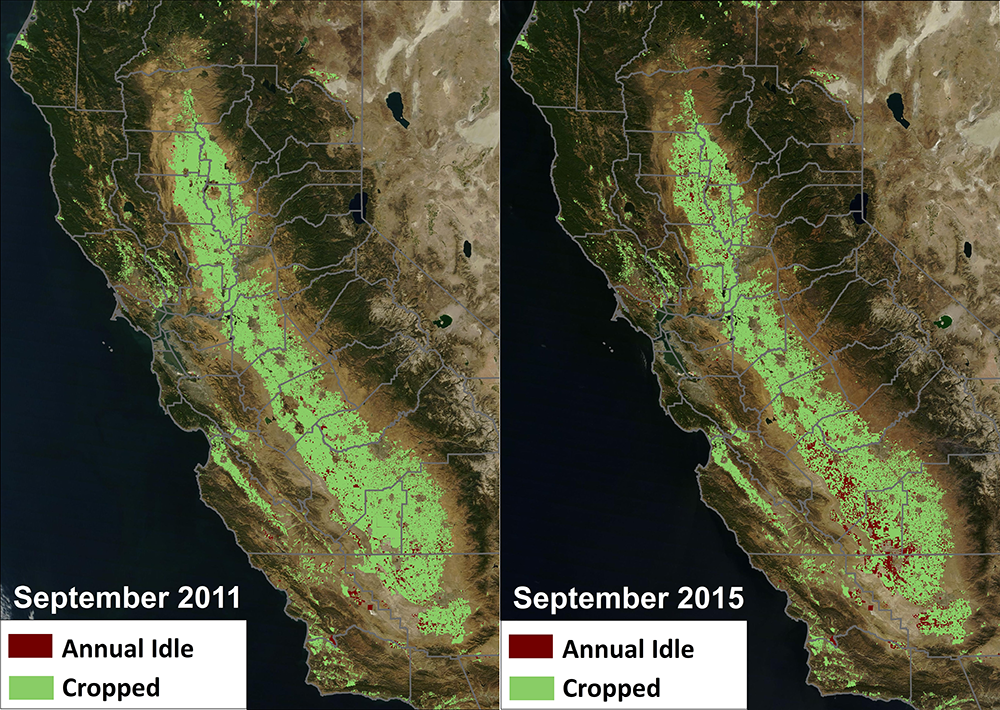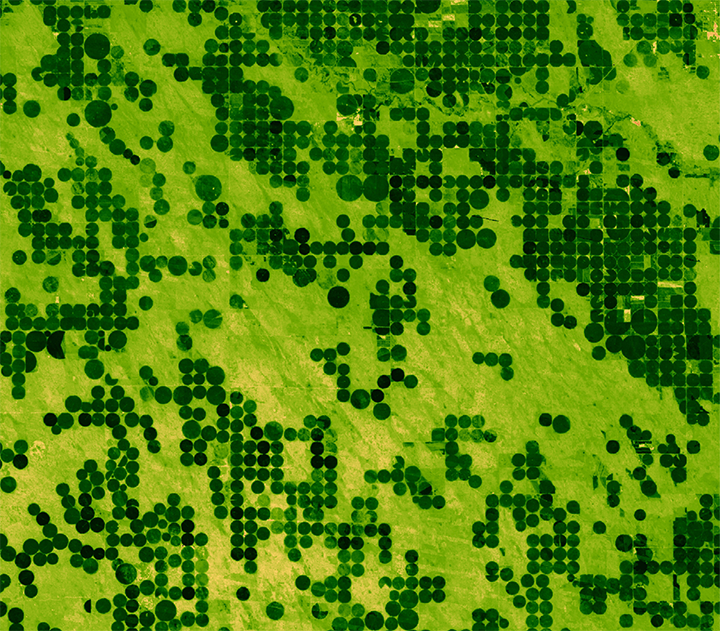News Archives
Monitoring Small Surface Water Bodies in Africa
Naga Manohar Velpuri, works with the USGS Famine Early Warning Systems Network (FEWS NET). The project has recently initiated a large-scale project to monitor surface water bodies in the pastoral regions of Africa using multi-source satellite data and hydrologic modeling techniques. Currently, a total of 293 water points are being monitored in 10 countries. Velpuri shared some of the projects findings he presented at #AGU15.
Watching Glacial Sediment Plumes in Alaska's Lake Clark
Carson Baughman, a geographer at the USGS Alaska Science Center, presented results of his study on seasonal glacial sediment plumes in Alaska’s Lake Clark at #AGU15. We talked to Carson about his work.
Detecting Landslides in Nepal with Landsat
Justin Roberts-Pierel from the Joint Center for Earth Systems Technology, uses Landsat 8 to detect landslides in the Himalayas. He provided information about his studies at #AGU15. We talked with him about his work.
An Integrated Look at Barrier Islands: Assateague to Metompkin
A new Landsat-based report from the USGS St. Petersburg Coastal and Marine Science Center takes an integrated look at barrier islands.
How Hurricane Sandy Affected New Jersey Coastal Marshes
Alex Riter, a graduate student at the University of Maryland College Park, presented her finding on how Hurricane Sandy affected New Jersey coastal marches at #AGU15. We talked to Riter about her research.
How the 2010 Haitian Earthquake & Resulting Human Migration Affected Landslide Occurrences
At #AGU15 Yurika Kato, a Geosciences graduate student at the University of Missouri-Kansas City, presented his research about how the 2010 Haitian earthquake and resulting human migration affected landslide occurrences in the Port-au-Prince province. We spoke with Kato about his research.
Using Landsat to Measure Chlorophyll in the Chesapeake Bay
Sara Lubkin, previously with the NASA DEVELOP program, presented a poster at #AGU15 on her work using Landsat data in concert with MODIS data to measure chlorophyll levels in the Chesapeake Bay. We spoke with Lubkin about her work.
Mapping Antarctic Rock Outcrops with Landsat 8
Alex Burton-Johnson, Martin Black, and Peter Fretwell from the British Antarctic Survey have used Landsat 8 data to create a new rock outcrop map for Antarctica, which will become part of the Antarctic Digital Database. The team presented their research at #AGU15.
News Archives

Federal Agencies Release Data Showing California Central Valley Idle Farmland Doubling During Drought
NASA, in collaboration with the United States Department of Agriculture (USDA), United States Geological Survey (USGS), and the California Department of Water Resources, released data today showing the effect the current drought has had on agricultural production and the idling of California farmlands.
United States and European Union Sign Cooperation Arrangement on Copernicus Earth Observation Data
The European Commission and the United States signed the “Copernicus Cooperation Arrangement” which will facilitate data sharing from the Copernicus constellation of Sentinel Earth Observation satellites among a broad spectrum of users on both sides of the Atlantic.
The Chesapeake Bay in 661 Million Pixels
Imagine you’re flying 438 miles above the Earth taking pictures and collecting information of everything below. What do you see? Now imagine you’ve been doing this non-stop for over 40 years. Do you notice any change?

Tracking Agricultural Water Use on a Smartphone
This fall scientists at the University of Nebraska, with partners at Google Inc., the University of Idaho and the Desert Research Institute, introduced the latest evolution of METRIC technology—an application called EEFLUX, which will allow anyone in the world to produce field-scale maps of water consumption.
Barrier Island Shorelines Extracted From Landsat Imagery
Landsat enables coastal geomorphologists to observe changes to barrier islands on annual and decadal time scales—providing information about island size, shape and position, as well as erosion, land loss and island breakup.
NASA LCLUC Spring 2015 Science Team Meeting Summary
The NASA Land-Cover/Land-Use Change (LCLUC) Program held its annual spring Science Team Meeting (STM) on April 22-23, 2015, in College Park, MD.
A forest by any other name? Semantics, carbon implications, and solutions
Using the world’s first global, Landsat-based 30-meter resolution map of tree cover, researchers found that ambiguity of the term “forest” has the potential to create 13 percent discrepancies in forest area maps. While ecologists have long understood the complexity comprised by the concept of “forest”, and while geographers have called for the term to be more uniformly defined across monitoring entities, no one had quantified the scope of the problem.
Over 150 Landsat Images Provided to the International Charter in September 2015
This month, 166 Landsat scenes were ingested by the USGS Hazard Data Distribution System to provide data for Charter activations.
Landsat Images Advance Watershed Restoration in Western Tanzania
For those who live along its shores, Lake Tanganyika in east Africa is the backbone of local transportation and serves as an essential source of household water and protein. Every night, fishers lure nocturnal, sardine-like fish called dagaa with compression lamps that are strung between their boats. From the shore, the lake sparkles with the lights of miniature moons as people gather the treasured catch.
News Archives

Federal Agencies Release Data Showing California Central Valley Idle Farmland Doubling During Drought
NASA, in collaboration with the United States Department of Agriculture (USDA), United States Geological Survey (USGS), and the California Department of Water Resources, released data today showing the effect the current drought has had on agricultural production and the idling of California farmlands.
United States and European Union Sign Cooperation Arrangement on Copernicus Earth Observation Data
The European Commission and the United States signed the “Copernicus Cooperation Arrangement” which will facilitate data sharing from the Copernicus constellation of Sentinel Earth Observation satellites among a broad spectrum of users on both sides of the Atlantic.
The Chesapeake Bay in 661 Million Pixels
Imagine you’re flying 438 miles above the Earth taking pictures and collecting information of everything below. What do you see? Now imagine you’ve been doing this non-stop for over 40 years. Do you notice any change?

Tracking Agricultural Water Use on a Smartphone
This fall scientists at the University of Nebraska, with partners at Google Inc., the University of Idaho and the Desert Research Institute, introduced the latest evolution of METRIC technology—an application called EEFLUX, which will allow anyone in the world to produce field-scale maps of water consumption.
Barrier Island Shorelines Extracted From Landsat Imagery
Landsat enables coastal geomorphologists to observe changes to barrier islands on annual and decadal time scales—providing information about island size, shape and position, as well as erosion, land loss and island breakup.
NASA LCLUC Spring 2015 Science Team Meeting Summary
The NASA Land-Cover/Land-Use Change (LCLUC) Program held its annual spring Science Team Meeting (STM) on April 22-23, 2015, in College Park, MD.
A forest by any other name? Semantics, carbon implications, and solutions
Using the world’s first global, Landsat-based 30-meter resolution map of tree cover, researchers found that ambiguity of the term “forest” has the potential to create 13 percent discrepancies in forest area maps. While ecologists have long understood the complexity comprised by the concept of “forest”, and while geographers have called for the term to be more uniformly defined across monitoring entities, no one had quantified the scope of the problem.
Over 150 Landsat Images Provided to the International Charter in September 2015
This month, 166 Landsat scenes were ingested by the USGS Hazard Data Distribution System to provide data for Charter activations.
Landsat Images Advance Watershed Restoration in Western Tanzania
For those who live along its shores, Lake Tanganyika in east Africa is the backbone of local transportation and serves as an essential source of household water and protein. Every night, fishers lure nocturnal, sardine-like fish called dagaa with compression lamps that are strung between their boats. From the shore, the lake sparkles with the lights of miniature moons as people gather the treasured catch.

